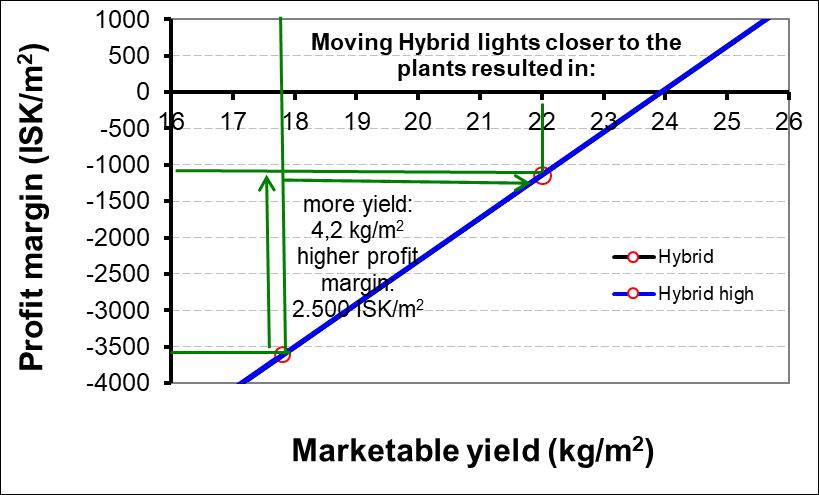
4 minute read
Tab. 11: Marketable yield per cluster with different light treatments
Fig. 40: Profit margin in relation to yield with different heights of the lights in tomato production – calculation scenarios.
Marcelis et al. (2006) reported that generally, it can be said that 1% increase of light intensity is resulting in a yield increase of 0.7-1.0% for fruit vegetables. These values are in accordance with the present findings: A 1% increase of µmol/m2/s (compare “Hybrid high” with “Hybrid”) resulted in a yield increase of 1%. In earlier experiments, where the light intensity (W/m2) of HPS top lights was increased, were values of 0.7% reported (Stadler, 2013).
When the marketable yield per cluster was set into relation to the number of harvested clusters (Tab. 11), the marketable yield per cluster was not influenced by the light source, but by the height of the light source over the canopy, indicating that with a higher light level also a higher yield can be gained.
Tab. 11: Marketable yield per cluster with different light treatments.
Treatment
HPS Hybrid high Hybrid
Yield (kg/m2) 21,8 17,8 22,0 Harvested clusters (no/m2) 26 25 26 Yield (kg/cluster) 0,84 0,71 0,85
BRIX content did not increase, when Hybrid lights were lowered and with that the µmol level increased. Indeed, also Kowalczyk et al. (2018) found that the taste desirability was similarly high for cucumbers irrespectively of HPS top lighting, HPS top lighting + LED interlighting or LED top lighting + LED interlighting. But Verheul et al. (2022) observed that with a higher amount of HPS top lights and LED interlights increased BRIX content in the fruits. This increase was related to an increase in dry matter content of the fruits.
It can be expected that a higher µmol level will cause a higher transpiration from the plants. The presented results show a higher humidity in the Hybrid treatment where a higher µmol level was reached by lowering the lamps.
As “Hybrid” and “Hybrid high” used the same energy, the energy use efficiency could be significantly increased by 20% by lowering the lamps and with that increasing the photosynthetic photon flux density. This was in accordance to results from Verheul et al., (2022) where a higher light intensity (242 W/m2, HPS top lighting) used less energy per kg tomato produced compared to a lower light intensity (161 W/m2, HPS top lighting). Dueck et al. (2012a) compared the effect of top lighting and interlighting with HPS and/or LEDs on the production of tomatoes. The amount of energy required per kg of harvested tomatoes was highest for the LED treatment and Hybrid system with LED top lighting. In cucumbers, LED interlighting increased light use efficiency, mainly by increasing light reaching the inter canopy, compared with HPS top lights (Hao et al., 2014). Moreover, the response of cucumbers to LED interlighting could be optimized by using proper crop management (e.g. plant density) and ratio of top light / interlight. In contrast, in the presented experiment was the electricity per yield only dependend on the height of the lights and decreased with less distance between lights and plant canopy. Also, “Hybrid” transferred the used kWh’s better into yield than “Hybrid high”.
5.3 Future speculations concerning energy prices
When tomatoes were grown under HPS lights in young plant production, the energy costs were as high as under Hybrid lights. In contrast, Stadler (2020) reported higher savings with LED top lighting without compromising yield of tomatoes: Using LEDs was associated with about 40% lower daily usage of kWh’s, resulting in lower expenses for the electricity compared to the use of HPS top lights. With the use of LED top lights were energy costs (distribution + sale) per kg yield lowered by 45% compared to the use of HPS lights. However, the investment into LEDs was nearly double the price as for HPS lights. Meaning the higher price of the LEDs compensated their lower use of electricity (Stadler, 2020). In contrast, in the presented experiment where the investment costs into Hybrid lights double the price as the treatment that received only HPS lights. The lower costs in HPS lights were reached by investing in 1000 W bulbs instead of 750 W bulbs as it was the case in the Hybrid light treatment. With that, a fewer number of lamps was needed to reach the same light level and with that could investment costs be lowered. This resulted in total light related costs that were more than 50% higher for “Hybrid” compared to “HPS”.
In terms of the economy of lighting it is also worth to make some future speculations about possible developments also regarding the fluctuation of the subsidy. So far, the lighting costs (electricity + bulbs) are contributing to a big part of the production costs of tomatoes. In the past and present, there have been and there are still a lot of discussions (for example in Bændablaðið, 11. tölublað 2022, blað nr. 612) concerning the energy prices. Therefore, it is necessary to highlight possible changes in the energy prices (Fig. 41). So far, the lighting costs are contributing to about 1/3 of the production costs.
The white columns are representing the profit margin according to Fig. 38. Where to be assumed, that growers would get no subsidy from the state for the distribution of the energy, that would result in a profit margin of -10.400 to -14.500 ISK/m2 (black columns, Fig. 41). Without the subsidy of the state, probably less Icelandic growers would produce tomatoes over the winter months. When it is assumed that the energy costs, both in distribution and sale, would increase by 25%, but growers would still get the subsidy, then the profit margin would range between -770 to -4.800 ISK/m2 (dotted columns). When it is assumed that growers must pay 25% less for the







